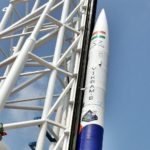 |
| In the 21st century, the role of the private sector has dramatically expanded. (Illustration: Sasi Kumar) |
The launch of the Vikram S rocket last week has been rightly hailed as an important milestone in India’s outer space journey. It is the first privately built Indian rocket to make it to space, and is a result of a major push by Prime Minister Narendra Modi to open up the Indian space programme for greater participation by Indian start-ups.
The single-stage, solid-fuel rocket was built with “carbon composite structures and 3D-printed components,” according to startup Skyroot Aerospace that developed the rocket.
Compared to current platforms, Skyroot seeks to reduce development costs for launching small satellites by up to 90%. Starting next year, it intends to carry out satellite-delivery launches.
Skyroot’s Vikram-S mission is named after the father of India’s space program, Vikram Sarabhai.
Eyeing larger commercial space sector stake
In order to supplement its publicly-funded space program, which is renowned for its low-cost launches and missions, the Indian government has been working to create a commercial space sector.
It seeks to increase its current 2% market share in commercial space industry globally.
India became the first Asian country to reach Mars in 2014 with its Mangalyaan orbiter, launched by ISRO. It cost only $74 million (€76.59 million) to build.
In October, 36 broadband satellites were successfully launched into low earth orbit by ISRO.
Privatizing State-Owned Companies in Vietnam
When Vietnam started privatizing state-owned enterprises in the 80s, the private sector, which includes local businesses, began to flourish. When Vinamilk, a dairy product company, was privatized the company expanded globally, and today are operating in more than 43 countries, surpassing $2.2billion revenues in 2018. That’s a lot of milk! By IMF
India’s 1st Privately-Built Rocket Vikram-S Launch Shortly: 10 Points
Vikram-S is one of the world’s first few all-composite rockets that has 3-D printed solid thrusters for spin stability of the launch vehicle, according to news agency PTI.








